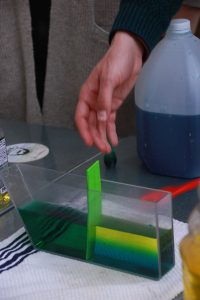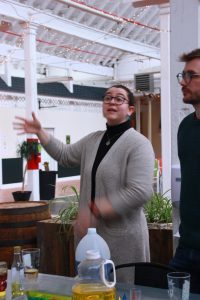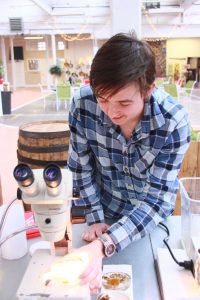We are delighted to share the success of our recent outreach event Sip N’ Science, where we brought our science projects to the local community.
by Mengyang Zhou
This March, graduate students in DMS hosted “Sip N’ Science” at Beer’d Brewery in Stonington Connecticut. This event was featured with fun and interactive scientific presentations from 18 dedicated graduate students. These science demonstrations covered a wide range of ocean science topics, through which they showcased the diverse and impactful research we do at DMS.
We know that the ocean generates 50% of the Earth’s oxygen, and absorbs 30% of anthropogenic CO2, therefore playing a critical role in regulating climate and supporting life on the Earth. However, global warming can affect the ocean’s capability to absorb greenhouse gas. Anagha Payyambally and Kelsey Ward teammates did a very simple experiment to demonstrate this. They took a beaker with cold water and another with hot water. Following that, they dipped test tubes containing carbonated drinks in each beaker. There was rapid bubbling and degassing in the test tube that was placed in the hot water, which implies that a rise in temperature decreases the solubility of gasses in water.
Anagha Payyambally and Kelsey Ward demonstrating the temperature dependence of gas solubility in the ocean. Photo credit: Hung Nyugen
Riley Pena, a Ph.D. student studying benthic marine ecology, put together a tank of local rocky intertidal organisms, including mussels, barnacles, and herbivorous and carnivorous snails. People were able to watch the barnacles feeding on plankton in the water and handle the snails and juvenile crabs. For a lot of people, this was their first time to see barnacles feeding.
Riley showing the tanks of benthic organisms to kids. Photo credit: Hung Nguyen
Two of our physical oceanography graduate students, Molly James and Luke Glass, showcased an engaging hands-on activity centered around ocean density and its role in shaping circulation patterns. The demonstration involved pouring salty and fresh water each dyed a different color into opposite sides of a narrow table-top tank with a removable divider down the middle. Participants were posed with intriguing questions: What happens when the divider separating the two waters is removed? Will the waters mix or remain separate? Similar to the interaction between a river plume and the ocean, and in global thermohaline circulation, the denser (saltier) water sank beneath the fresher water, resulting in the formation of two distinct layers with a slightly mixed interface between them. Both adults and children were captivated by the distinct layers that emerged during the experiment. These density-driven, or baroclinic, flows play a crucial role in various phenomena observed in both coastal and open ocean environments. Want to learn more? Check out this YouTube video: https://youtu.be/dVeAhK-PM3M?si=5RBG1l9FnU_UYRuc
Molly James and Luke Glass showcasing the salt and fresh water mixing. Photo credits: Hung Nguyen
Samantha Rush and her labmates demonstrated ocean acidification to the public using a SodaStream. Just like the SodaStream adds carbon dioxide to carbonate your beverages into a soda, they added carbon dioxide to our seawater samples. By having bromothymol blue (a pH dye indicator that is blue in a base and yellow in an acid), they could track how the pH changed visibly from a base to an acid! They also showed that adding in chalk (like that of a coccolithophore shell) rapidly bubbles in acidic water which demonstrated how acidic water can be damaging to carbonate shells. The goal was showing how anthropogenic inputs are changing the carbonate system! Their whole lab enjoyed conversing with the public and getting to watch the visitors see the pH changes visibly rather than just telling them numbers!
Samantha Rush and her labmates demonstrating ocean acidification. Photo credit: Hung Nyugen
Members of the Vaudrey Lab, Matthew Leason and Emily Watling showcased the distinctions between eelgrass (Zostera marina) and seaweed while shining a spotlight on the Connecticut National Estuarine Research Reserve (CT NERR). Using centrifugal tubes of suspended seaweed and seagrass, as well as a poster, they illustrated these distinctions and encouraged attendees to use the methods found on the poster to replicate an experiment at home, demonstrating photosynthesis in seaweed. The table also highlighted ongoing CT NERR projects, including invasive plant mapping, with contributions from dedicated undergraduate interns. They said they had a fantastic experience this year at Sip N’ Science and were excited to return next year!
Matthew Leason and Emily Watling with their poster and samples of eelgrass and seaweed. Photo credits: Hung Nyugen
Rowan Batts set up dissecting microscopes with samples from a plankton tow at Avery Point, for people to see tiny planktonic organisms that are otherwise invisible. Visitors gained a greater understanding of plankton diversity and abundance by observing copepods jumping around and guessing the number of cells in a laboratory phytoplankton culture.
Rowan Batts setting up the microscopy. Photo credit: Hung Nyugen
We appreciate the efforts graduate students made for Sip N’ Science. This event is not just about presenting our science and findings; it is more about sparking curiosity and passion for ocean sciences among the public, especially kids. Through the interactive science demonstrations set up by graduate students at DMS, we raised awareness of marine environmental problems, such as how ocean acidification may influence marine organisms. This event also helped us build connections with the local community, through which we can work together for a more sustainable ocean.









